|
Related FAQs: Sea
Urchins, Urchins 2, Urchins 3, Urchin Identification, Urchin Behavior, Urchin Compatibility, Urchin Selection, Urchin System, Urchin Feeding, Urchin Disease, Urchin Reproduction,
Related Articles: Echinoderms, An Introduction to the
Echinoderms: The Sea Stars, Sea Urchins, Sea Cucumbers and
More... By James W. Fatherree, M.Sc. Algae Control, Nutrient Control and
Export,
/A Diversity of Aquatic
Life
Some Spines
Now! Sea Urchins (and Sand Dollars), the Echinoids, Pt. 4
To:
Part 1, Part
2, Part 3,
Part 5, Part 6
|
%20MD.JPG)
|
|
By Bob Fenner
|
Echinometra mathaei
|
Genus Echinometra:
| Echinometra lacunter, the Rock-Boring
Urchin. Dark colored with red highlights. 2-3 inches in
diameter. Relatively short, pointed spines. Reddish centers. Tropical West
Atlantic. |
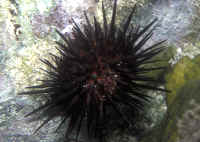
|
Bigger PIX:
The images in this table are linked
to large (desktop size) copies. Click on "framed" images
to go to the larger size. |
|
%20MD.JPG)
|
| Echinometra mathaei (Blainville 1825), the
Common Urchin. Indo-Pacific; Red Sea to Hawai'i. To about four
inches overall diameter. Hides by day in rocky crannies it helps
gouge. Mostly eats algae it rasps from rocks by night. In Oahu,
Hawai'i by day. |
Bigger PIX:
The images in this table are linked
to large (desktop size) copies. Click on "framed" images
to go to the larger size. |
|
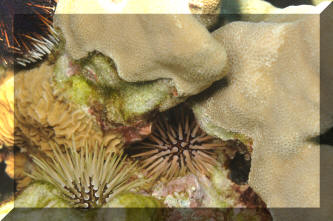
%20MD.JPG)
|
| Echinometra viridis, the Reef Urchin. 2-3
in. diameter. Pointed purple to brownish spines with a white ring
around their base. Tropical West Atlantic. Feed during the night
(hide in coral, rock by day) on algae. Cozumel image. |
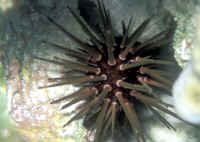
|
Bigger PIX:
The images in this table are linked to large
(desktop size) copies. Click on "framed" images to go to
the larger size. |
|
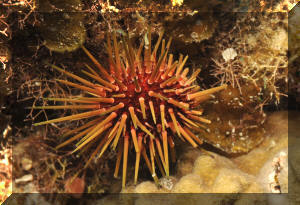
|
Genus Echinostrephus:
| Echinostrephus aciculatus Agassiz 1893, the
Rock Boring Urchin. N. Sulawesi pic. |
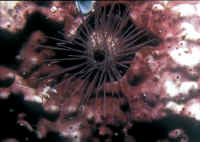
|
Bigger PIX:
The images in this table are
linked to large (desktop size) copies. Click on "framed"
images to go to the larger size. |
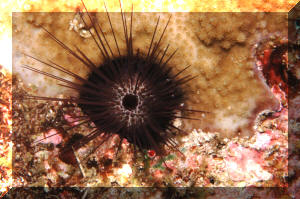
%20MD.JPG)
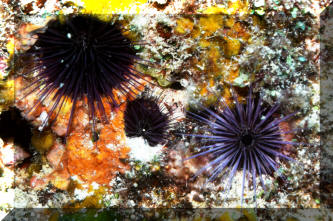 |
Family Echinothuriidae: Pinhead Sea Urchins.
| Asthenosoma varium Grube 1866,
the Pinhead Sea Urchin. Family Echinothuriidae. Indo-West Pacific;
Red Sea to Indonesia. Test size to six inches in diameter; spines
to twelve. Nocturnal, not safe kept with other invertebrates. Walks
on spines and/or tube feet. Takes all foods. This one in the Red
Sea. |
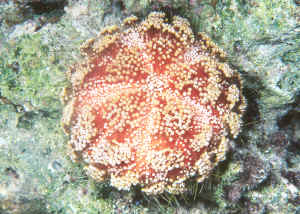
|
Bigger PIX:
The images in this table are
linked to large (desktop size) copies. Click on "framed"
images to go to the larger size. |
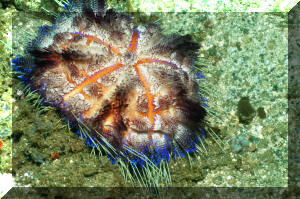
%20MD.JPG)
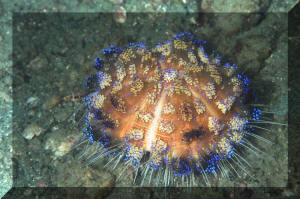 |
Family Strongylocentrotidae:
| An image to show you what cooler water Urchins
can/do look like. The larger, redder individual in the upper part
of the frame is the larger species, Strongylocentrotus sanfriscanus, the ones in the
foreground are the more common, smaller Strongylocentrotus
purpuratus. Both have their eggs used in the sushi bar business
as uni. |
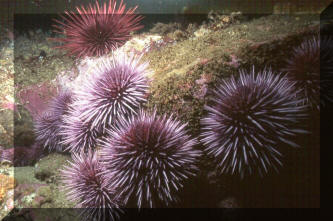
|
To:
Part 1, Part
2, Part 3,
Part 5, Part 6
|
|

